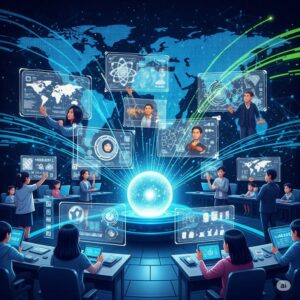Bridging the Gap from Campus to Cloud in Teacher Preparation

 Public education in the United States has been an evolving concept since Horace Mann’s original idea of free, non-sectarian, state-funded schools staffed with professionally trained and highly skilled teachers. While there is no one defining moment that K-12 public schools were, per se, created, they have undergone a significant evolution since the late 1800s and early 1900s, when compulsory education became the standard for educating the nation’s children. After World War II and the passing of the GI Bill, federal investment in educational infrastructure created a broader culture of standards-based education that significantly expanded public schools from urban to suburban areas. As home and private schooling were gradually replaced by public education as the preferred mainstream educational model, states began to strengthen teacher education and licensing requirements, prompting more colleges and universities to begin offering education majors and specialized endorsements. Accordingly, the original mission of public education has changed from focusing on civic education and social order to career readiness and global competence as society has advanced and progressed both economically and socially. There have also been notable cultural, legislative, judicial, and political moments in public education’s history that have created drastic shifts in educational policies and priorities. We need only look to our immediate past for such transformative examples such as A Nation at Risk Report (1983), No Child Left Behind (2001), Common Core Standards (2010), and Every Student Succeeds Act (2015). Perhaps the greatest modern transitional impact on K-12 public education was the rapid and unexpected shift to remote learning as a result of the 2020 pandemic. This moment holds great significance more than any other in contemporary educational history because it brought to light the substantial disparities in technological aptitude and competence among pre-service and in-service teachers and the immediate need for educator preparation programs (EPPs) and school districts to completely and thoroughly modernize and revise technology training. This resulted in EPPs making a distinction between three concepts to better reflect the necessary advancements in teacher technology training: 1. Technology application; 2. Technology competency; and 3. Technology savviness.
Public education in the United States has been an evolving concept since Horace Mann’s original idea of free, non-sectarian, state-funded schools staffed with professionally trained and highly skilled teachers. While there is no one defining moment that K-12 public schools were, per se, created, they have undergone a significant evolution since the late 1800s and early 1900s, when compulsory education became the standard for educating the nation’s children. After World War II and the passing of the GI Bill, federal investment in educational infrastructure created a broader culture of standards-based education that significantly expanded public schools from urban to suburban areas. As home and private schooling were gradually replaced by public education as the preferred mainstream educational model, states began to strengthen teacher education and licensing requirements, prompting more colleges and universities to begin offering education majors and specialized endorsements. Accordingly, the original mission of public education has changed from focusing on civic education and social order to career readiness and global competence as society has advanced and progressed both economically and socially. There have also been notable cultural, legislative, judicial, and political moments in public education’s history that have created drastic shifts in educational policies and priorities. We need only look to our immediate past for such transformative examples such as A Nation at Risk Report (1983), No Child Left Behind (2001), Common Core Standards (2010), and Every Student Succeeds Act (2015). Perhaps the greatest modern transitional impact on K-12 public education was the rapid and unexpected shift to remote learning as a result of the 2020 pandemic. This moment holds great significance more than any other in contemporary educational history because it brought to light the substantial disparities in technological aptitude and competence among pre-service and in-service teachers and the immediate need for educator preparation programs (EPPs) and school districts to completely and thoroughly modernize and revise technology training. This resulted in EPPs making a distinction between three concepts to better reflect the necessary advancements in teacher technology training: 1. Technology application; 2. Technology competency; and 3. Technology savviness.
Keeping this considerable skill gap in mind, what does education, especially distance and virtual education, really mean in the 21st century? What should we prioritize in terms of potentially transitioning traditional human-to-human to technology-to-human teaching and learning? How can educators effectively and practically apply technology such that their use is intentional and meaningful and does not degrade the robust human experience expected in any classroom learning setting?
While 21st-century education continues to transform and progress, it is imperative that EPPs place a stronger emphasis on the effective application of technology into teaching and learning modalities, whether those modalities are traditional human-to-human or technology-to-human. The dynamic and systemic digital transformation of K-12 public education has permanently reshaped the expectations and responsibilities of future and current educators. It is now expected that classrooms will extend beyond physical walls, and emerging teachers must be effusively prepared to design and deliver high-quality, technology-forward instruction no matter the classroom’s location.
To meet the demands of 21st-century learners, pre-service teachers must be able to not only demonstrate expected pedagogical content knowledge but do so with the digital aptitude and instructional skills necessary for technology-enhanced distance and virtual learning instruction that is designed with purpose and intention. However, too many teacher preparation programs still view educational technology as an afterthought or soft skill. This is especially the case with today’s modern pre-service teacher, as oftentimes technology savvy is mistaken for technological aptitude and competence. This aptitude gap leaves new teachers woefully underprepared for blended, hybrid, and fully online teaching modalities, which are becoming increasingly common in K–12 public education, especially post-pandemic.
Therefore, it is vital that EPPs include a required component of clinical field experience and student teaching in distance or virtual learning classrooms. By participating in these technology-enhanced learning technosystems, pre-service teachers engage in firsthand experience managing and instructing in digitally enhanced or virtual classrooms, actively engaging students through digital platforms, while using data from learning management systems such as Canvas and large language models such as Khanmigo to personalize instruction. These experiences build methodological confidence and technical competence, ensuring that new educators are ready to teach effectively in any modality.
Requiring clinical and student teaching experiences in virtual teaching environments is foundational and proactive in preparing emerging teachers who are adaptive, innovative, and responsive in K-12 classrooms that continue to change as emerging technologies progress them forward, bridging the gap from campus to the cloud, freeing educators to teach without limits.

Rebecca Blankenship
Rebecca J. Blankenship is an award-winning educator and researcher with over 25 years of
teaching experience. Her current research examines the ecologies of meanings as a systems-based, hermeneutic approach to ethics in AI and gen-AI teaching and learning modalities. She is currently an Associate Professor in the College of Education at Florida Agricultural and Mechanical University.
